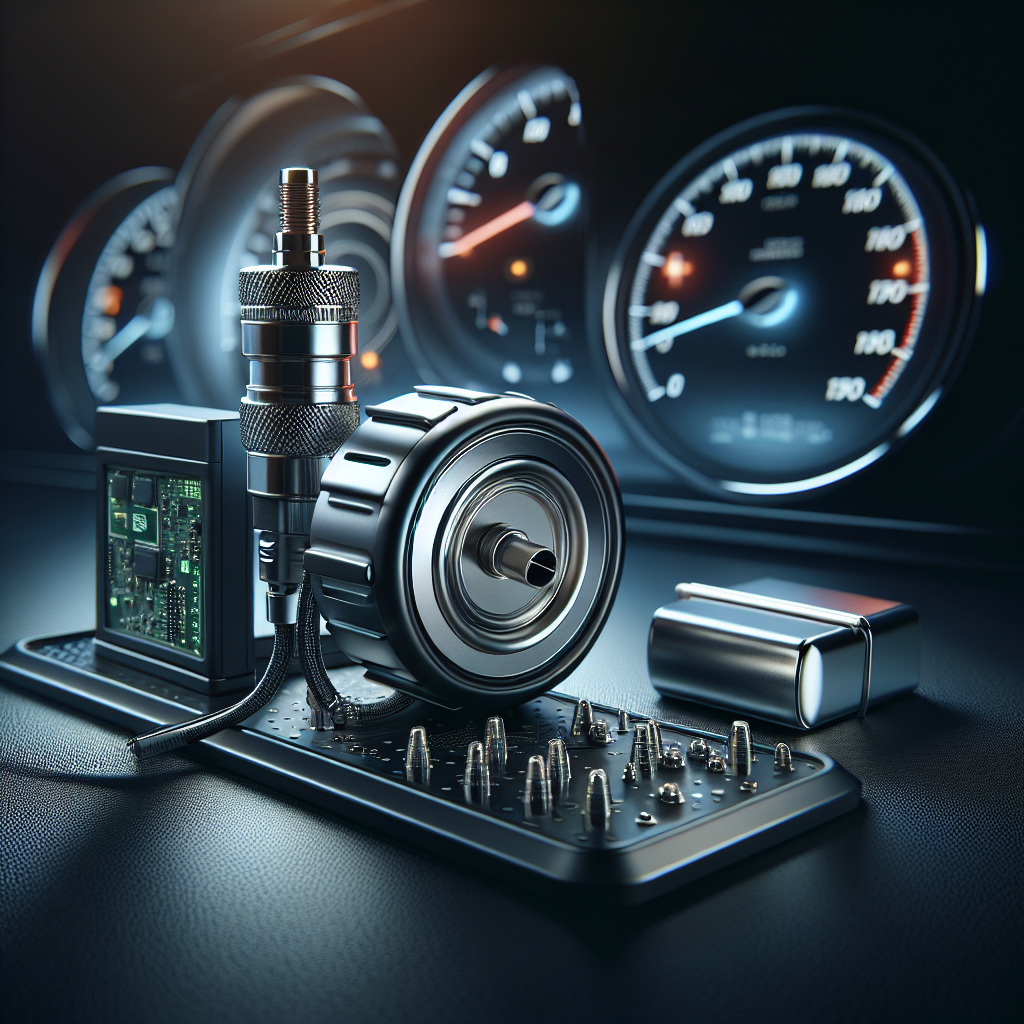Tire pressure sensors are essential components in modern vehicles that monitor the air pressure within the tires, ensuring they operate at optimal levels. Understanding how tire pressure sensors work is crucial for drivers who wish to maintain vehicle safety and efficiency. These sensors typically consist of several key components:
- Pressure Transducer: This part measures the pressure inside the tire and converts it into an electrical signal.
- Transmitter: The transmitter sends the pressure data wirelessly to the vehicle's onboard computer.
- Battery: Most tire pressure sensors are equipped with a battery, which powers the sensor and its components, ensuring consistent operation.
When tire pressure falls below recommended levels, the sensor detects this change and triggers a warning light on the dashboard. This alert is vital as driving on under-inflated tires can lead to poor fuel efficiency, increased tire wear, and even tire blowouts, which can have catastrophic consequences.
Moreover, tire pressure sensors enhance vehicle safety by providing real-time data, allowing drivers to make informed decisions about tire maintenance. Regular monitoring can prevent accidents and costly repairs, making these sensors an integral part of vehicle safety systems.
To ensure your trailer is equipped with the latest safety technology, tow with peace of mind, knowing that trailerwatchdog is standing guard. Visit trailerwatchdog.com for more information on our innovative monitoring solutions.
How Tire Pressure Sensors Measure Pressure

Understanding how tire pressure sensors measure pressure is essential to grasping their functionality and importance in vehicle safety. These sensors utilize various technologies to accurately gauge the air pressure within each tire, ensuring drivers are alerted to any potential issues.
Most tire pressure sensors operate using one of two primary methods:
- Direct Measurement: This method involves a pressure transducer located inside the tire that directly measures the air pressure. The transducer converts the pressure into an electrical signal, which is then transmitted to the vehicle's onboard computer. This real-time data allows for immediate alerts if the pressure falls below the recommended levels.
- Indirect Measurement: Instead of measuring tire pressure directly, indirect systems use data from the vehicle's ABS (Anti-lock Braking System) to estimate tire pressure. By monitoring the rotational speed of the tires, the system can identify discrepancies that indicate low pressure. However, this method is less precise than direct measurement.
In both methods, the sensors are designed to operate within a specific pressure range and are calibrated to provide accurate readings under various driving conditions. When tire pressure drops significantly, the sensor triggers a warning light on the dashboard, prompting the driver to take action.
The effectiveness of tire pressure sensors in maintaining proper inflation levels not only enhances vehicle safety but also contributes to better fuel efficiency and tire longevity. By ensuring that tires are always at their optimal pressure, drivers can enjoy a safer and more economical driving experience.
The Role of Tire Pressure Monitoring Systems

The role of tire pressure monitoring systems (TPMS) extends beyond merely alerting drivers about tire pressure. These systems play a crucial part in enhancing overall vehicle safety and performance. By constantly monitoring tire pressure, TPMS helps prevent tire blowouts and accidents caused by under-inflated tires.
TPMS typically functions in two ways: direct and indirect monitoring. Direct TPMS features sensors located within each tire that provide real-time pressure readings to the vehicle's dashboard. This immediate feedback allows drivers to address any issues before they escalate. In contrast, indirect TPMS relies on wheel speed sensors to detect variations in tire circumference, which may indicate low pressure.
Here are some key benefits of having a TPMS:
- Enhanced Safety: By alerting drivers to low tire pressure, TPMS significantly reduces the risk of tire-related accidents.
- Improved Fuel Efficiency: Properly inflated tires reduce rolling resistance, leading to better fuel economy.
- Tire Longevity: Maintaining optimal tire pressure extends tire life, saving money on replacements.
- Environmental Benefits: Better fuel efficiency and prolonged tire life contribute to reduced carbon emissions.
Moreover, many modern vehicles come equipped with TPMS as standard, and regulations in various countries mandate their inclusion. As technology advances, TPMS continues to evolve, integrating with other vehicle systems to provide even more comprehensive monitoring and alerts.
Benefits of Using Tire Pressure Sensors
Utilizing tire pressure sensors offers numerous advantages that significantly contribute to both driver safety and vehicle efficiency. These sensors not only monitor tire pressure but also provide valuable insights that enhance the overall driving experience.
One of the primary benefits of tire pressure sensors is the increased safety they provide. By continuously monitoring tire pressure, these sensors alert drivers to any deviations from the optimal range. This proactive approach helps prevent potential blowouts and accidents caused by under-inflated tires, ensuring safer journeys.
In addition to safety improvements, tire pressure sensors can lead to cost savings. Properly inflated tires improve fuel efficiency, resulting in less frequent trips to the gas station. Moreover, maintaining the correct tire pressure extends tire life, reducing the need for premature replacements. This not only saves money but also lowers environmental impact by minimizing waste.
Another notable benefit is the enhanced vehicle performance. Well-inflated tires provide better traction, improved handling, and increased stability while driving. This translates to a smoother ride and more responsive steering, which is especially important in challenging driving conditions.
Lastly, tire pressure sensors contribute to driver convenience. Many modern systems integrate with mobile apps, allowing drivers to monitor their tire health remotely. This feature promotes regular maintenance checks and encourages responsible driving habits.
Common Issues with Tire Pressure Sensors

While tire pressure sensors offer significant benefits, they are not without their challenges. Understanding these common issues can help drivers maintain their systems effectively and ensure optimal performance.
One prevalent issue is sensor malfunction. Like any electronic device, tire pressure sensors can fail due to various reasons such as age, exposure to harsh weather conditions, or physical damage from road debris. A malfunctioning sensor may provide incorrect readings, leading to potential safety hazards.
Another common concern is battery life. Many tire pressure sensors are battery-operated and can deplete over time. When a sensor's battery fails, it may stop working entirely, which can result in a lack of monitoring and unexpected tire issues.
Improper installation is also a frequent problem. If the sensors are not fitted correctly during tire changes or replacements, they may not function as intended. This can lead to inaccurate readings and compromised safety.
Furthermore, environmental factors such as extreme temperatures can affect sensor performance. For instance, colder weather can cause tire pressure to drop, potentially triggering false alarms or causing the system to alert the driver unnecessarily.
Lastly, communication issues can arise between the sensors and the vehicle's onboard diagnostic system. Interference from other electronic devices or poor signal reception can lead to delayed or missed alerts, undermining the system's effectiveness.
Ensuring Safety with Tire Pressure Monitoring

Ensuring safety while driving is paramount, and tire pressure monitoring systems (TPMS) play a crucial role in achieving this goal. By continuously monitoring the tire pressure, these systems provide real-time data that helps prevent tire blowouts and other related accidents caused by improper tire inflation.
A well-functioning TPMS alerts drivers to low tire pressure, allowing for timely action to avoid dangerous situations. This can significantly improve vehicle handling, fuel efficiency, and overall safety on the road. Regular checks and maintenance of the tire pressure sensors can ensure that this vital system operates effectively.
Moreover, integrating additional technology like TrailerWatchdog's monitoring system can further enhance safety for trailer users. This advanced system not only monitors tire pressure but also tracks axle temperature, providing comprehensive data that can prevent catastrophic failures.
By investing in a reliable tire pressure monitoring solution, drivers can have peace of mind knowing they are taking proactive steps to maintain their vehicle's safety. The combination of routine maintenance, awareness of common issues, and the use of advanced monitoring systems creates a robust safety net for all drivers.
Tow with peace of mind, knowing that trailerwatchdog is standing guard.








